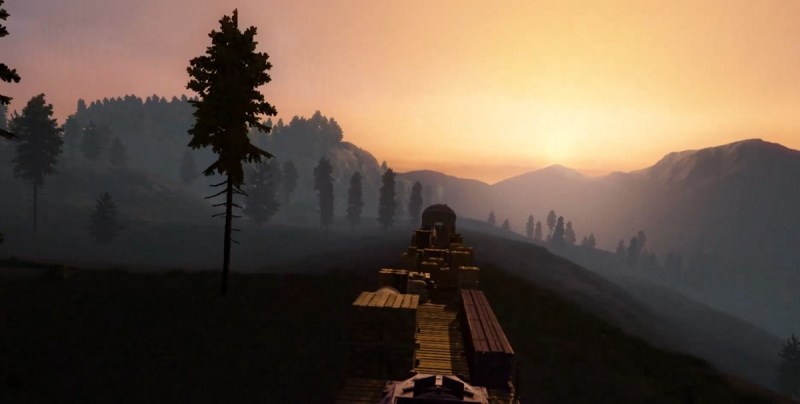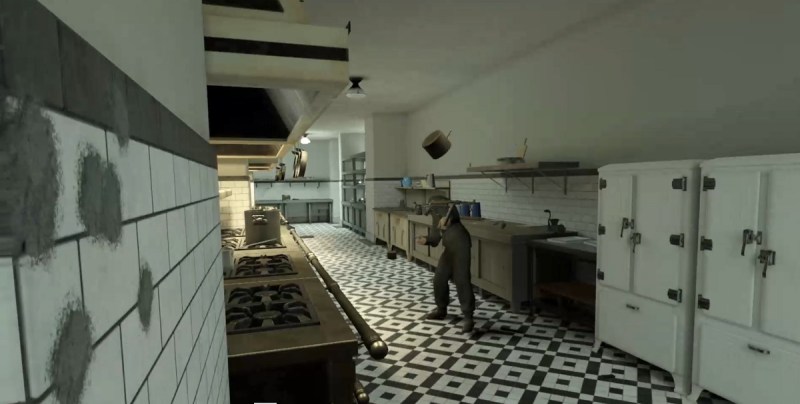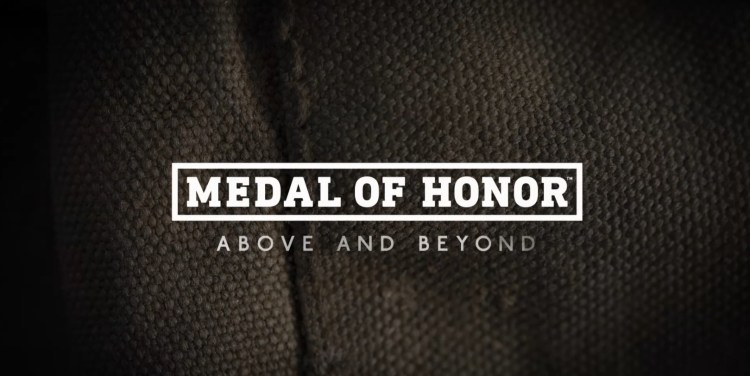
Above: You can catch a grenade in Medal of Honor: Above and Beyond by holding up your arm.
Question: I was almost deceived into thinking that my hands were actually vibrating. When I was shooting, I could see this happening, but there’s no motion feedback, right?
Doran: There is haptic feedback in the controller, actually.
Hirschmann: We’re trying to make it as authentic as possible.
Question: You mentioned earlier on that you used some of the characters from the original games. Even from the first trailer, it seemed very familiar. Are you using locations from the previous games?
June 5th: The AI Audit in NYC
Join us next week in NYC to engage with top executive leaders, delving into strategies for auditing AI models to ensure fairness, optimal performance, and ethical compliance across diverse organizations. Secure your attendance for this exclusive invite-only event.
Hirschmann: Yes. Dubuisson, which is the town that was featured prominently in the first three games, plays a big part. Again, I’m very proud that as a franchise — our second Medal of Honor game, Underground, featured a woman protagonist. You played as Manon, who’s the leader of the French resistance cell. You played her the whole game, and that was a PlayStation game.
We’ve always tried to tell the complete story. Even at the highest level, acknowledging that it was an allied effort. We always highlight the British contribution, the Battle of Britain. It’s not just America, rah rah rah. The story of the war is so big that you can only focus on one little slice at a time, but highlighting that it’s an allied effort, and especially the French resistance — they’re some of the bravest people that fought in the war.
Your country is taken over and occupied, you have three choices: surrender, collaborate, or resist. The people that resisted, the courage to do that, where you’re not only fighting Germany, but your neighbor is going to turn you in if they think it’ll give them an advantage — that’s something we try to build in to the narrative, especially in the first part of the game. To be in the resistance was to live in a constant state of fear and paranoia. The Germans are after you. Collaborators are after you. You don’t know who else is in the resistance. The cell structure keeps that knowledge contained. Some of the most dangerous things the resistance members would do — if they ever had to make contact with another cell, they were immediately under suspicion.
We have a level in the game where you have to do that. It’s a mission based directly on one of the interviews we did with someone who fought in the resistance. She said the scariest thing that ever happened to her was, she was delivering a message to another cell. They captured her on the road thinking that she was a spy from the Gestapo, because she had information that she shouldn’t have had. They put her up against a wall and were about to shoot her until she was able to convince them she was on their side.
So we have a level where you have to make contact with another cell and they ambush you. They pop up and say, “Drop your weapons. Put your hands up.” That’s something you can do in VR. You actually have to drop your weapon and put your hands up, because we can measure the gestures you’re making. It’s a great scary moment in VR. You’re standing there like this and they have their weapons pointed at you and they’re interrogating you. “Who are you? Why are you here?”

Above: You play an OSS operative in Medal of Honor: Above and Beyond.
Question: If you don’t do that, can you get shot?
Hirschmann: Yep. What’s the right way to put it? It’s a fulfilling payoff. If you think you can just screw around, they’re not going to mess around. Stuff that, we’re constantly looking to implement. Again, there are no quick time events, no “Press X for this.” We try to build as much natural human movement into the activities as we can.
Just the act of letting go of the weapon and throwing up your hands — you’re making yourself vulnerable. If you go for your weapon, we’re able to track — when we were prototyping our gesture system, we actually had a Simon Says game, where the AI would just randomly run through animations, and you had to respond. It was just a silly little designer game, but it was cool. You had to match what they were doing, and the system could track that.
Question: You mentioned the motorcycle mission. Are there driveable vehicles?
Hirschmann: Rideable. You’re on the back of the motorcycle shooting Nazis, and then you leap onto the train. We have a B-17 where you’re a passenger.
What I love about the B-17, a lot of games have put you in a bomber, but you actually get to walk around here, look out the window. At one point you’re hit by flak and the engine catches on fire. I think we showed that in the trailer. That’s some of my favorite stuff. You can see a B-17 in a museum. I paid $300 a couple years ago to take a flight in one. It’s an amazing experience. But there aren’t combat missions flown over Europe anymore, thank God. To be able to put the player in that situation, where the crew is arming the .50 cals and the flak is blowing up around you, enemy fighters are coming in, over planes are getting hit — it’s very easy to lose yourself in that.
It’s a game, but it gives you maybe a little insight into what it must have been like. Those bomber missions, you had to fly 25 of them before you could go home. Imagine the scariest flight of your life and people are shooting at you. You somehow through the grace of God survive, and then you have to do it again and again. That’s one of the little slices of the war that we wanted to tell. Getting to experience that with the crew and see how the react.
Question: How did you choose some of these missions? Battlefield V has some similar elements, like the resistance and the Norway mission.
Hirschmann: There’s a finite amount of WWII history. We get kind of meta about the Norway one, because the Nynorsk hydro plant, outside Rjukan in Norway, that’s where they did the heavy water research. The SOE, the OSS, the RAF, the Norwegian resistance, they were constantly sabotaging and blowing it up, and then the Germans would get it back online. We leaned into that. The Allies keep attacking this and the Germans keep getting it online.
In ours, the timeline is near the end of the war. You’re going in and blowing it up one last time. We did it first, actually. We had a heavy water mission in the original Medal of Honor, which took place earlier in the war. Battlefield V actually followed us.
There are certain touch points in the WWII story that we wanted to revisit, mainly because we’d done them in earlier Medal of Honor games. The platform opened up a fresh way to approach it. But just the fact that we’re doing VR wasn’t enough. To just replay Allied Assault’s D-Day level on the Rift would be cool, but it’s not enough.
In our game, you’re a combat engineer who’s recruited into the OSS. Combat engineers had a very specific job on D-Day. They had to blow the obstacles and clear a path for the armor to land. We do a whole setup where you’re in the OSS. You know the invasion’s coming. Your former engineer unit’s going in with the first wave. Engineers were the first ones on the beach. The OSS won’t let you go. “You’re a trained operative now. We won’t send you into a meat grinder.”
Our D-Day mission actually starts in a very unexpected way. You’re being told you can’t go, and you find a way to break loose of your OSS shackles and find out where your unit’s deploying from, steal a jeep, and do all this in way where….

Above: Yes, you can throw a pot at a Nazi in Medal of Honor: Above and Beyond.
Question: You’re defecting.
Hirschmann: [laughs] Yeah, yeah. But the first part of that mission is about getting to the port to hook up with your guys. There’s this neat moment where you sneak aboard the transport ship and you lean over, and there’s the Higgins boat down at the bottom. Your old unit’s like, “Holy shit, the lieutenant’s back!” You get to climb down the netting into the Higgins boat, and then you’re off to the beach.
One of the reasons we wanted to do that is also because a lot of D-Day levels start in the Higgins boat. You fade up and it’s “30 seconds!” and the ramp comes down. One of the vets we interviewed, he was on Omaha Beach. Talking to him about it, the story that made a huge impact, they were rousted up and everyone was loaded into trucks. They weren’t told that this was the invasion. They obviously put two and two together as they were going, though, and he said that the ride from camp to the port in the back of the truck was the quietest and darkest, with everything all blacked out.
There are these guys in there — they weren’t all chatting about existential crises. Sometimes those scenes can be overwritten. People talk in ways they don’t. For hours they all just sat in the back of the truck and it was dead quiet. They’re all terrified out of their mind, thinking about what’s coming. We wanted to capture a little bit of that. The journey to the port is part of the story. That’s a full third of the Omaha Beach stuff, breaking away and figuring out where you need to go, stealing a jeep, getting rid of the MPs.
Question: For you, knowing the difference between Medal of Honor and Battlefield, would Medal of Honor VR be a very different thing from Battlefield VR?
Hirschmann: With Medal of Honor, it’s a much more intimate experience. There’s no bigger Battlefield fan than me. Battlefield 1942 is one of my touchstone experiences as a gamer. The fantasy fulfillment of these big epic battles — it boggles the mind. Certainly the more recent Battlefield games, what they’re able to pull off is crazy.
We come at it the other way. It’s much more up close and personal. It’s that tactical relationship, not with 100 people, but with one, two, three, four guys at a time. That intimacy, for lack of a better term, is what helps define Medal of Honor from the get-go. Being a part of the OSS allows us to send you to some very interesting places where the stakes are incredibly high. Sometimes the outcome of the war depends on it.
Question: I saw you’re doing performance capture for the animation. Are you also doing facial capture?
Hirschmann: Yeah. We do — what kind of capture don’t we do? You guys all saw Into the Spider-Verse, right? Derek Esparza, his name comes above the title. He was a supervising animator on it. After he finished that, he came to our team.
We do spotting sessions for every single level. There are more than 50 of them. We go through square foot by square foot and look for places to animate behaviors and actions that fall outside the normal AI. We’re trying to go super deep with the AI and those core functions, but looking for spots where — here’s a tired German commander issuing orders. He knows the invasion is going well and they’re losing. Derek and his team will capture that on stage.
Then we have all the narrative stuff. We differentiate between mocap and P-cap. We have a whole cast of actors, and we do facial capture at the same time. They act out the narrative script. It’s more than 120 pages. It’s similar to a feature film. It’s an amazing cast. Chris Edgerly, who plays Pathfinder in Apex, is one of our key characters. He’s a fantastic actor.
Then you saw the stunt stuff, which is a whole specialized thing. As we do those spotting sessions, invariably there will be one or two that’s something like a guy falling off a ship, or jumping out of a speeding truck. That’s something where we need to hire a stunt team. Once we get critical mass on that, we’ll book a stage for a few days. They come in and set up the rigging. It’s crazy, a huge stunt crew. We mocap all that. The body dynamics you get out of that are fantastic.
All of those feed into the game. Every line of dialogue is animated. We use a couple of different processes to do that. You never shoot the same Nazi twice. It’s a lot. We’re really tired. [laughs] We’re really tired!
Doran: It’s a level of production quality that’s not been done in VR before. Certainly not at this scale. We see it asked quite a bit: “When are the big names coming to VR?” This is the first. There are more coming. It’s been exciting to see these guys deliver on that.
Question: I felt like I had to unlearn how to move and reload at the same time. I’m standing in the middle of the room reloading and I realize, “Wait, I should be moving now.”
Hirschmann: That’s right. That’s exactly right. I’m so happy to hear that. It’s such a waste of time if we just made a traditional HD game in stereo, right? Who cares? It’s about finding ways — it’s this, man. It’s the motion controls. Truly, in our industry, it’s the first time that it’s true one to one. I was at LucasArts for years, and I’ll tell you, my inbox was never more flooded than when the Wii was announced. You can make a lightsaber game now!
That was not true one-to-one. This is the first time where you’re looking at your virtual avatar and your actions are matching what you’re doing in real life. That just opens up a world of possibilities, especially when you have to duck and dodge and lean around corners.
My favorite thing, when we first got it up and running, was that adrenaline rush you had as a kid playing hide and seek. You’d peek around the corner. Oh, there’s the bad guy! You can do that in VR. Especially if you’re waiting for a guy on sentry duty to come get closer. Peeking out, “Oh, shit, shit!” You’re in a level where you see his shadow getting closer and closer. It’s pretty neat.
Again, what a waste of time it would be if we just ported a game over. This was built from the ground up to take advantage of this platform.

